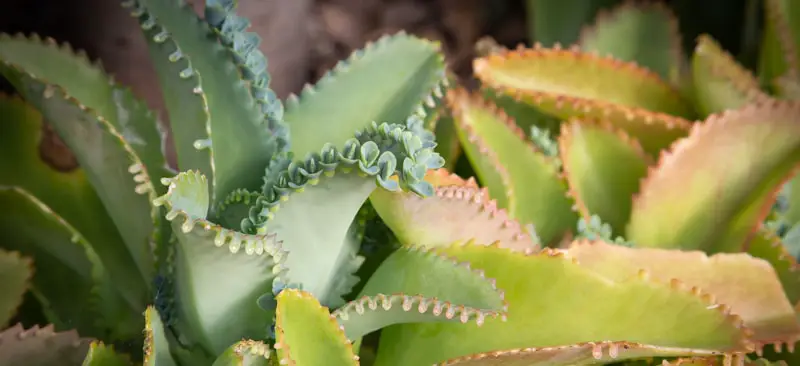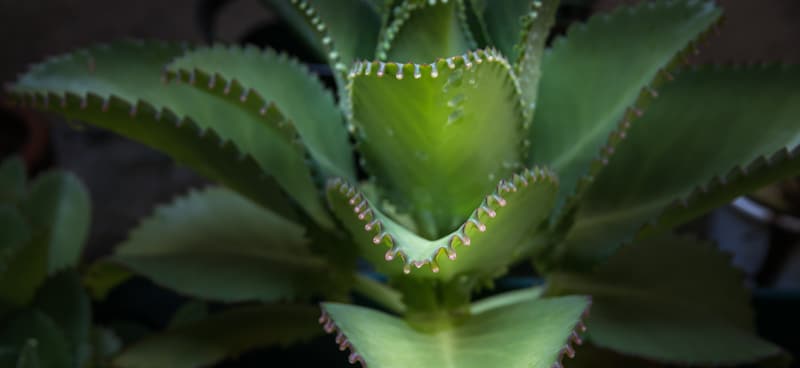The Mother of Thousands plant is a gorgeous and exciting houseplant that’s trendy these days. If you decide to keep one of these plants in your house, you should know how to take care of it so it survives for years.
Mother of Thousands requires a well-draining potting mix, thorough and infrequent watered, and bright, indirect daylight with minimal humidity at 65-75° F. The minute plantlets that mature along the borders of the leaves require maintenance as they try to grow wherever they end up landing.
This blog covers all you need to know about caring for a mother of Thousands plant. Before that, we delve into the details and origins of this beautiful plant.
The Mother Of Thousands Plant
Mother of Thousands has many other names, including Mexican Hat, Alligator, and Devil’s Backbone. Originating from Madagascar, the plant is a luscious shrub that matures from a single stem. The sizeable blue-green leaves are pointy and slender and mature to lengths of up to six inches and widths of three. It can grow as tall as 18-35 inches with adequate care.
The unique part of the plant is its minute plantlets that mature along the borders of the leaves. These little sprouts can fall swiftly from the parent plant, trying to grow wherever they drop and find soil ideal for maturity.
For that purpose, many gardeners consider the mother of Thousands a problematic houseplant option. The little sprouts require time and effort to mature and multiply in all dirt with other plants.
You can now tell how the plant gets its most popular name – it mothers thousands of different plants! When keeping Mother of Thousands inside, you don’t have to worry much about its propagation. Still, you might feel that the little sprouts fall into adjacent plant pots, where they also start to grow.
How To Care For A Mother Of Thousands Plant
Light
A Mother of Thousands plant requires adequate light. In the warmer months, keep the plant in indirect daylight. If not, its fragile leaves can quickly get sunburnt. In the colder season, from fall till spring, when the days aren’t as hot, you can keep the plant in direct daylight to get adequate light every day.
A Mother of Thousands plant can flourish if your window faces east. It loves direct daylight in the morning since it’s not as hot even in the summer. Windows that face north are typically an inadequate option for the mother of Thousands since there aren’t enough hours of sunlight for it in that direction, even in summer.
Your Mother of Thousands plant is receiving the ideal amount of sunlight – the leaves have vivid-green coloration and a lovely red outline. When it isn’t getting enough sunlight, it grows frail and tall, increasing in height. Significant spaces between its leaves can make the plant look scant and weak.
Temperature
If doable, Mother of Thousands ideally grows in temps between 65 and 75 F (16 and 24 C). When your internal heating is on during the cold season, avoid direct heat from the plant. Not only can that injure the leaves, but it can also result in the plant drying out too fast.
Pot
The plant’s roots are fragile and mature best when they have proper air circulation. The ideal pot choice is terracotta with bottom holes so that excess water can quickly drain out. You can upgrade the drainage mechanism by adding pebbles or tiny stones at the pot’s base.
Keep the pot into a dish or tray for the excess water drains out, and empty the tray when it fills with water. The plant doesn’t mature well in wet or humid conditions. If you allow the mother of Thousands to grow in water, its roots can start to decay, resulting in plant damage.
The Mother of Thousands grows well in small pots. The larger the container, the more sizeable the leaves and the taller the plant is. For thicker plants, plant the mother of Thousands in a more compact pot, switching the size as the plant matures.
These plants don’t always share space with other plants in their pots – their saplings can quickly take over. Avoid planting buddy plants together, even if you have enough pot space. If not, you might see the mother of Thousands take over, and the buddy plant won’t thrive.
Soil
The Mother of Thousands matures best in sandy dirt with good drainage. A potting mix ideal for cacti is an attractive choice. You can create your mix if you can’t acquire sandy potting soil. Mix some coarse sand to standard pot soil. There are some other things you can mix in the ground for better drainage:
- Perlite: crushed volcanic glass that keeps potting soil light and loose.
- Pumice: helps to ventilate the soil and keep it loose.
- Vermiculite, made from mica, retains enough moisture in the dirt while allowing good aeration.
Watering
Water the soil for a mother of Thousands thoroughly. Before its next watering, let the pot dry out so that the first two inches of dirt are thoroughly dry.
Always use room temperature water for watering. The roots are vulnerable to temperature, so too cold or hot water can shock and damage them. Ensure to only water the soil and not the leaves since they are prone to decay if wet.
During the cold season, you can water the plant less often, giving just enough so that the dirt stays soggy without excess saturation. Don’t let the soil completely dry out. If not, you may dry it out to the point where you can’t save it!
Pruning
Like other houseplants, the mother of Thousands of plants needs occasional trimming. If the plant begins to look tough and lean, snip off the top above a sizeable leaf. That can encourage leaves to grow further down the stem.
Propagation
A Mother of Thousands has an easy propagation process with its saplings. Firstly, choose two or three saplings from one of the leaves. If you don’t plan to plant them immediately, seal them in a plastic bag or wrap them. It would be best to keep them soaking until they’re ready for use.
Take a tiny terracotta and put it in some cactus soil. Don’t worry about getting a deep or sizeable container – the sapling roots can take time to mature enough for a bigger pot.
Put the saplings directly on the soil, ensuring they’re about half an inch apart. Spray the earth and the saplings with water so they’re wet without excess moisture. Then cover the terracotta with plastic wrap to make a DIY greenhouse.
Place the pot where it can get enough daylight – then keep the dirt and saplings moist without overwatering. Otherwise, they tend to rot, so they become unusable. Mother of Thousands doesn’t grow well in humidity –the same goes for its plantlets.
Monitor the plantlets as they start to grow. Correct the plastic wrap’s position to avoid crushing the plants. You can stick a toothpick in the dirt to form a tent over the wrap. When they’re around one inch tall, please take off the plastic wrap and keep them in daylight as they continue to mature. You’ll see some new plants with tiny pink or purple flowers if you’re lucky.
Once the plants are mature enough, you can divide them and plant them in individual pots. Remember that the roots of the new plants are very delicate and get damaged easily. Make a broad cut into the dirt to avoid scratches on the roots when moving them.
Final Words
Taking care of the “Mother of Thousands” plants is much work. It involves the right kind and amount of water, soil, space, and effort. But once you learn how to care for the plant, you’ll have a whole yard full of them. Happy gardening!
Victoria is the owner and main author of hobby plants. She loves spending her free time in her garden planting and taking care of her plants. Victoria hopes you enjoy the content here!


![Queen Of The Night Flower [Complete Plant Care Guide] Queen Of The Night Flower [Complete Plant Care Guide]](https://www.hobbyplants.com/wp-content/uploads/2022/07/queen-of-the-night-flower-300x158.jpg)
![Majesty Palm Plant Care: [Complete Beginner's Guide] Majesty Palm Plant Care: [Complete Beginner's Guide]](https://www.hobbyplants.com/wp-content/uploads/2022/08/majesty-palm-care-300x158.jpg)
![Exotic Angel Plant Care: [Complete Beginner's Guide] Exotic Angel Plant Care: [Complete Beginner's Guide]](https://www.hobbyplants.com/wp-content/uploads/2022/08/exotic-angel-plant-care-300x158.jpg)
![Snow White Waffle Plant: [Complete Care Guide] Snow White Waffle Plant: [Complete Care Guide]](https://www.hobbyplants.com/wp-content/uploads/2022/08/snow-white-waffle-plant-300x158.jpg)
![Waffle Plant Care: [Complete Beginner's Guide] Waffle Plant Care: [Complete Beginner's Guide]](https://www.hobbyplants.com/wp-content/uploads/2022/08/waffle-plant-300x158.jpg)
![Bird Of Paradise Plant Care: [Complete Beginner's Guide] Bird Of Paradise Plant Care: [Complete Beginner's Guide]](https://www.hobbyplants.com/wp-content/uploads/2022/08/bird-of-paradise-plant-300x158.jpg)
![Purple Passion Plant Care: [Complete Beginner's Guide] Purple Passion Plant Care: [Complete Beginner's Guide]](https://www.hobbyplants.com/wp-content/uploads/2022/08/purple-passion-plant-care-300x158.jpg)
![China Doll Plant Care: [Complete Beginner's Guide] China Doll Plant Care: [Complete Beginner's Guide]](https://www.hobbyplants.com/wp-content/uploads/2022/09/china-doll-plant-care-300x158.jpg)
![Polka Dot Plant Care: [Complete Beginner's Guide] Polka Dot Plant Care: [Complete Beginner's Guide]](https://www.hobbyplants.com/wp-content/uploads/2022/09/polka-dot-plant-300x158.jpg)
![Mona Lisa Lipstick Plant Care: [Complete Beginner's Guide] Mona Lisa Lipstick Plant Care: [Complete Beginner's Guide]](https://www.hobbyplants.com/wp-content/uploads/2022/09/lipstick-plant-mona-lisa-300x158.jpg)
![Yucca Cane Plant Care: [Complete Beginner's Guide] Yucca Cane Plant Care: [Complete Beginner's Guide]](https://www.hobbyplants.com/wp-content/uploads/2022/09/yucca-cane-plant-care-300x158.jpg)
![Bush On Fire Croton Plant Care: [Complete Beginner's Guide] Bush On Fire Croton Plant Care: [Complete Beginner's Guide]](https://www.hobbyplants.com/wp-content/uploads/2022/09/bush-on-fire-croton-300x158.jpg)
